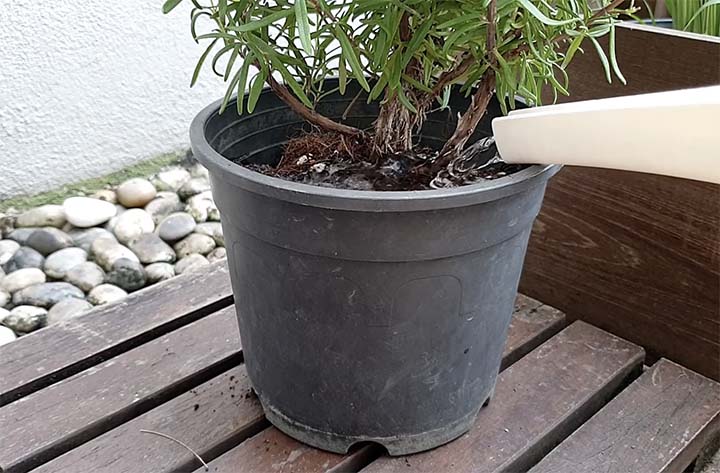If you’re looking for a fragrant and beautiful addition to your garden, look no further than rosemary. Rosemary adds a lovely aroma and visual appeal to any garden and thrives as a container plant indoors or outside. It has always been one of my go-to garden favorites.
One thing about rosemary that is fantastic is that it is super easy to grow as long. As long as you give it the right amount of water, this sweet herb will reward you with its beauty, fragrance, and functionality.
How Much Water Does Rosemary Need?
The amount of water that your rosemary plant needs depends on several main factors.
- Climate: In warmer, dryer climates, rosemary will need to be watered more frequently, while cooler, moister climates may require less water.
- Seasons: Generally speaking, rosemary plants should be kept evenly moist throughout the growing season and allowed to dry out between watering sessions to help prevent root rot. During hotter summer months, rosemary requires more frequent watering than in other months- especially winter.
- Location: Potted rosemary generally requires more water than garden plants. This is because container plants lose moisture quickly. Be diligent with checking soil moisture levels of potted rosemary – especially during the summer months or in dry climates.
Below, please find some specific tips for watering rosemary.
How Often to Water Rosemary?
Watering Rosemary Indoors
When it comes to watering rosemary indoors, the key is to be consistent. Water your rosemary deeply and regularly so that the soil stays evenly moist but not soggy – a good rule of thumb is to water whenever the top inch or two of the soil feels dry.
To avoid root rot, ensure you’re not overwatering; wait until the soil is dry before you water again. If your rosemary is indoors, it may need to be watered more frequently than if planted outdoors in well-draining soil.
Indoor rosemary plants will likely need to be watered between 1 and 2 times a week during the growing season – just keep an eye on the soil and adjust as needed.
Avoid positioning your potted rosemary under a heating or air conditioning vent, which can cause the plant to dry out quickly.
If you’re unsure whether it’s time to water, stick your finger into the soil near the base of the plant and if it feels dry, go ahead and give it a good drink! Your rosemary will thank you for your extra care!
Watering Rosemary Outdoors
When it comes to watering rosemary planted in the ground outdoors, it’s essential to do so in a way that provides adequate moisture without over-saturating the soil.
Generally speaking, you should water your in-ground rosemary about twice per week in the summer and once per week in the spring, fall and winter.
Of course, this will depend on how much natural rainfall you receive, so just keep an eye on your plants and provide water when needed.
Ensure you’re providing enough water for your plant but not so much that it causes standing water in the root zone.
To ensure that your rosemary is healthy, check the soil around it every few days and water when the top inch of the soil is dry. When you water your rosemary outdoors, make sure to give it a deep watering, so it reaches the roots. Doing this consistently will help keep your plant happy and thriving.
Watering Rosemary in a Container
Water your rosemary in a pot in the same way you would water any other container herb. The key is to make sure the soil remains moist but not soggy.
About once every week (or when the top of the soil in the pot feels dry), give your rosemary some water. When watering, use enough so that the excess runs out of the drainage holes in the bottom of the pot. This will help to ensure that your rosemary gets enough water and is not sitting in too much moisture in its container.
If you are growing rosemary in a pot outdoors, water it more frequently in hot or windy weather. Finally, fertilize your rosemary in a pot about every other month to keep it healthy and happy.
Watering Rosemary Through the Seasons
Rosemary requires different amounts of water depending on the season. Here are some important watering tips to keep in mind to keep your plants happy and healthy.
Summer
Watering rosemary in summer is an important part of keeping your plant healthy. During the summer months, rosemary plants may need more frequent watering.
It’s important to keep the soil moist but not soggy since too much water can lead to root rot or cause the leaves to turn yellow and drop off.
When watering, make sure to soak the soil around the rosemary so that it penetrates deep into the roots.
Additionally, you can use mulch or a thick layer of pebbles around your plant to help keep the soil moist during summer heat waves.
Finally, pay attention to signs that your rosemary needs more water, and don’t be afraid to water it more frequently during the summer months.
If your rosemary leaves are starting to look brown or yellow, your plant may lack moisture. The leaves may also begin to curl up at the edges, indicating they aren’t getting enough hydration.
Spring
When watering your rosemary in the spring, remember that this herb needs to be kept moist but not soggy. Avoid overwatering, as too much moisture can cause root rot and stem dieback.
The ideal amount of water is around one inch per week, though you may need to adjust this depending on your location’s weather conditions. If the soil feels dry to the touch, or if your rosemary is looking wilted, it’s time to water.
Make sure to provide an even soak so that all parts of the plant receive adequate moisture. Additionally, avoid getting the leaves wet when you water your rosemary; the water at ground level instead. This will help prevent fungal and bacterial diseases from developing.
Fall and Winter
When it comes to watering rosemary in the winter, you need to be mindful of how much moisture your plant is getting.
During this time of year, rosemary is more likely to suffer from overwatering than underwatering because the air and soil are usually much drier.
Therefore, water only when the top couple of inches of soil is dry, and make sure to check for signs of overwatering, such as yellow or wilted leaves.
Additionally, you should reduce the amount of water your rosemary plant receives; a good rule of thumb is to cut back on watering by half compared to what you would give it in the summer months.
Finally, keep an eye out for any signs of pests or diseases, as rosemary is more susceptible to them in colder temperatures.
Watering Rosemary Seedlings
When it comes to seedlings – like rosemary seedlings in particular – you’ll want to give them enough water, but not too much. Make sure that the soil is kept moist without becoming soggy.
The best way to get the watering just right is to check the soil every couple of days.
Stick your finger a few inches into the soil; if it feels dry, give your seedlings a light watering. Overwatering seedlings can cause them to rot, so take care not to provide them with too much.
If you keep an eye on your seedlings and ensure they get just the right amount of water, they will soon be ready for transplanting.
Takeaway
Watering correctly is critical when caring for rosemary plants because overwatering or underwatering can lead to growth and health problems over time.
To avoid this issue, monitor how much moisture is in their soil and adjust accordingly. With proper care and attention – not forgetting about regular pruning – your rosemary will thrive for years!






